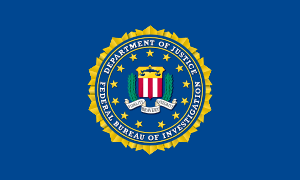FBI Intelligence Branch
| Federal Bureau of Investigation | |
|---|---|
 Badge of the Federal Bureau of Investigation | |
 | |
| Common name | Federal Bureau of Investigation |
| Abbreviation | FBI |
| Motto | Fidelity, Bravery, Integrity |
| Agency overview | |
| Formed | July 26, 1908 |
| Employees | 35,104[1] (October 31, 2014) |
| Annual budget | US$8.3 billion (FY 2014)[1] |
| Jurisdictional structure | |
| Federal agency (Operations jurisdiction) | United States |
| Operations jurisdiction | United States |
| Legal jurisdiction | As per operations jurisdiction |
| Governing body | U.S. Department of Justice |
| Constituting instrument | |
| General nature | • Federal law enforcement |
| Headquarters |
J. Edgar Hoover Building Northwest, Washington, D.C. |
|
| |
| Sworn members | 13,260 (October 31, 2014)[1] |
| Unsworn members | 18,306 (October 31, 2014)[1] |
| Agency executives |
|
| Child agencies | |
| Major units |
5
|
| Field offices | 56 (List of FBI Field Offices) |
| Notables | |
| People |
|
| Programmes | |
| Significant operation(s) | |
| Website | |
| www.fbi.gov | |
The Intelligence Branch (IB) division of the Federal Bureau of Investigation (FBI) handles all intelligence functions, including information sharing policies and intelligence analysis for national security, homeland security, and law enforcement purposes. The IB operates through the use of embedded intelligence strategies.
The Intelligence Branch consists of language analysts, physical surveillance specialists, and FBI agents. The IB also oversees field intelligence operations through Field Intelligence Groups (FIGs), housed within various localized offices.
Leadership
The Intelligence Branch of the FBI is headed by the Executive Assistant Director for Intelligence Branch.[2] The current Executive Assistant Director is Joshua D. Skule; appointed to the position by FBI Director James Comey on June 23, 2016.[3]
History
The operations of the FBI have significantly expanded and streamlined in the 21st century. The Intelligence Branch, as a distinct entity, came about in the wake of the September 11 terror attacks in 2001. Intelligence analysis became a critical focus for national security efforts, and the FBI Counterterrorism Division (CTD) soon evolved to include an Office of Intelligence (within CTD) in 2002. The 9/11 Commission recommended strengthening efforts to recognize the role intelligence played within the FBI's structure. Following the Intelligence Reform and Terrorism Prevention Act of 2004 being passed, United States Attorney General John Ashcroft ordered action on the development of an intelligence unit that would operate independently from the CTD. The Intelligence Branch was formally established in 2005. The IB, along with the CTD, the FBI Counterintelligence Division, and the FBI Weapons of Mass Destruction Directorate, became part of the newly-established FBI National Security Branch in 2006. As of 2014, the IB is no longer part of NSB and now operates as a department of the FBI.[4]
See also
References
- 1 2 3 4 "Frequently Asked Questions". Federal Bureau of Investigation. Retrieved 2016-09-02.
- ↑ FBI Organizational Chart, Federal Bureau of Investigation, July 15, 2014
- ↑ FBI National Press Office, 2016-23-06
- ↑ FBI Organizational Chart, Federal Bureau of Investigation, July 15, 2014
External links
